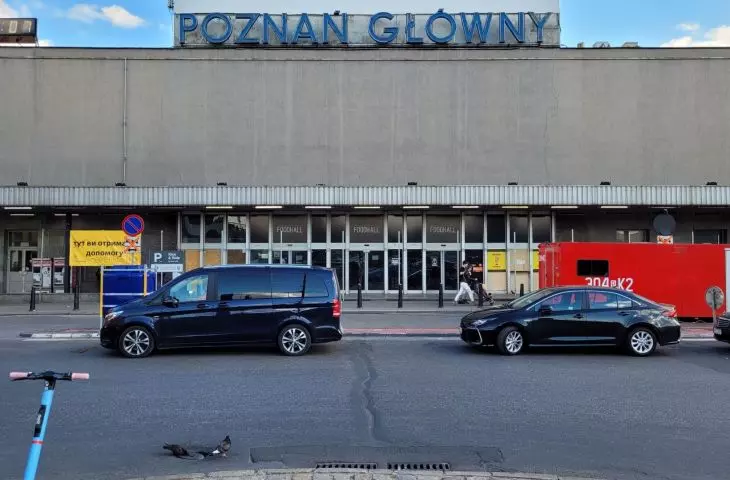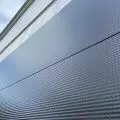Elections are coming, so Poznań residents are hearing again about the construction of a real main station. New announcements also talk about demolishing the old disused building and building new platforms. However, it's unclear what will happen to the so-called breadbox, an extremely unsuccessful station building from 11 years ago.
This is becoming a tradition. Ahead of the parliamentary elections, the topic of the Central Station is being revived in Poznań. An electrifying topic, because for 11 years the city has not had a real station, and the existing station is a non-functional and unsightly maze. Not only visitors, but even Poznań residents have problems with using it. Meanwhile, according to the latest report by the Railway Transport Office, it is invariably the second railroad station in Poland in terms of passengers served (after Wrocław).
Poznań Główny station—cramped and unsightly main (!) entrance to the „breadbox” from the Dworcowy bridge
photo: Jakub Głaz
to the train only through stores
Poznan's station drama began before the EURO 2012 championships, when railroaders entered into a consortium with Hungarian developer Trigranit. That's how a new flawed station building (nicknamed „breadbox” after its shape) was built over the eastern half of the platforms tacked on to a commercial molehill: the new Avenida shopping center on the station's south side. City authorities surrounded the new complex with a scaled-down and bizarre transportation system. They also defended themselves against the construction of a crosswalk—so that passengers could walk from the „breadbox” to the streetcar stop by the shortest possible route. Thus, the exit from the station took a long and forced route through the shopping center.
Poznań Główny station—general view of the „chlebak” from Towarowa Street; only one third of the building is occupied by the station, the rest is a small part of the shopping center (the whole CH is out of frame, on the left), the sidewalk directs towards the pedestrian crossing, which the previous city authorities did not want to build
photo: Jakub Głaz
It was only after the mayor and his deputies changed in 2014 that a crosswalk to the bus stops could be built without having to walk through the store. The new facility opened in 2012, and a year later the operation of the old and dilapidated station building was "extinguished"—conveniently located between platforms, larger and much more functional. Poznan residents quickly realized that new does not mean better, and began to demand the return of the station in its former location. So far, to no avail.
The railwaymen have only managed to add a new platform 1, sort out the numbering of all platforms as far as possible, and extend the station's pedestrian tunnel towards the city. However, it runs not, as would make sense, eastward, toward the Wilda district, but bends to the north to Składowa Street... along the new platform.
Poznań Główny station—the new 250-meter tunnel under platform 1 leads to the side of Składowa Street
photo: Jakub Głaz
The 250-meter-long tunnel and platform took as long as three years to build (commissioned as a whole earlier this year) and cost nearly PLN 100 million. In the process, the railroaders seem to have run out of money for a display with departure information at the new tunnel entrance. It's worth mentioning that this entrance resembles, to a large extent, the correct shelter of a garbage can on some housing estate.
Poznań Główny station—Składowa Street, entrance to the new tunnel—with the beauty of a garbage shed; no information on where it leads or a board of current departures
photo: Jakub Głaz
really decent, unpowdered
The business combination involving PKP, Trigranit and the City of Poznań thus avenges itself to this day, despite the fact that there have already been many hype announcements since 2015 about the restitution of the old building, its reconstruction, the erection of a new structure and so on. Those interested in the details are referred to our previous texts about the fate of the city's main station. Almost a year ago, the railroaders announced the modernization of the old building, but without an architectural competition. It was met with objections from the Poznań branch of SARP—rightly so, given the poor quality of previous PKP projects in Poznań.
Poznań Główny station—new platform 1, fragment of a historic shelter inserted into the clearance above the platform
photo: Jakub Głaz
Now, before the elections, the Poznan media have reported another surprising volition. The old building is to be demolished. In its place, between the two groups of platforms that exist today (and in place of the station square and Dworcowa Street), new tracks and platforms are planned. They would increase the capacity of the station and serve the high-speed railroad connecting Poznań with the Central Transport Port in Baranowo. And what about the station building? Here there are no specifics for now, which we are expected to learn later in August. Apparently, a large-scale investment is in the offing, with an underground connection to the Fairgrounds and good connectivity to the planned Musical Theater. This was announced more than a week ago by the mayor of Poznań in the pages of the local "Gazeta Wyborcza":
"We managed to work out [with PKP—editor's note] such a concept, thanks to which this will really be a decent station. It will be neither a powdering of the current building, nor some kind of update. Poznaners will get a modern station worth more than PLN 1 billion. [...] The only problem I see is that these arrangements will overlap with the start of the election campaign.
Jaskowiak's concerns are understandable, as the restoration of the old train station was announced in the previous campaign by Jadwiga Emilewicz, an MP from the ruling camp. She later renewed her promises from time to time, only shifting the dates.
clandestine arrangements
So we know they want to demolish, but we don't know much about what they want to put up. As usual with PKP, dialogue with residents and travelers is a pipe dream. No consultations have taken place, no alternatives have been presented, we haven't learned about functional analyses. Neither the city authorities nor the railroaders have addressed the demand made last September to consider a new location for the station, on the north side of the current station—between the Dworcowy Bridge and the junction at the Kaponiera traffic circle.
This idea, dating back to the 1930s, makes sense. The new station would be located at the western end of St. Martin, the main street in the downtown area, would give meaning to the existence of the scaled-down Kaponiera traffic circle, and would be equally accessible from the four sides of the world. However, it is not impossible that the PKP's new intentions concern this very spot.
For now, there have been comments from those involved in the city's transportation and rail issues. Some were offended by the information that the old building will cease to exist, because—unbeknownst to the numerous reconstructions—the walls of the building are part of the original shape of the 1880 station. According to several announcements and concepts made over the past decade, the outer form of the building was to be restored.
Poznań Główny station—the area between Dworcowy Bridge and Kaponiera, a place indicated as a new more sensible location for the station
photo: Jakub Głaz
Poznan SARP commented on the new reports about the station briefly on its Facebook profile:
For us, such information is another proof that both the city and railroad authorities do not have a clear vision of the place for us (residents, travelers). And the new arrangements, once again [have been made] with a disregard for the architectural community.
think about 2050!
City Councilman Pawel Sowa of the association Inwestycje dla Poznania, which has been fighting for a sensible and aesthetically pleasing station for the city for more than a decade, takes a slightly different perspective. On his Facebook fanpage he comments:
If the media information is confirmed, we will face a chance to sort out many of the problems of the entire Poznań Główny station: 1. increasing the station's capacity by building new several (maybe even six?) platform edges. Add through platforms, which are severely lacking today. 2. The possibility of extending the building of the new station in the direction of the Fair. 3. The possibility of building a plaza in front of the new station from the side of the Dworcowy Bridge—we all know how much pedestrian space is lacking there (narrow sidewalk on the south side of this overpass).
Poznań Główny station—Dworcowy Bridge towards the main entrance to the Fair, the station is on the left side
photo: Jakub Głaz
Dr. Michal Beim, a public transport specialist from Poznań University of Life Sciences (briefly a member of the board of directors of PKP SA in 2016-2017), is more restrained. He points to the need for forward thinking and dialogue with the public and specialists:
Until the railroad manager presents a master plan for the Poznań interchange, it is difficult to discuss whether the addition of more platforms and tracks, which involves the demolition of the old station, is necessary. The number of platform edges should result from the planned timetable that would be in effect in Poznań in 15 or 20 years. [...] The building of the new station itself must also be adjusted to this timetable for 2045 or 2050, from which it will be possible to estimate the number of passengers. [...] So it is worth preparing well for the modernization of Poznań Główny station. You can't make the previous mistakes, resulting from quick, decision-making without reliable social and industry consultations. It is also worth analyzing other solutions, not just demolishing the station itself.
Poznań Główny station—the junction of the old station with the parking lot at the „breadbox”
photo: Jakub Głaz
Beim's postulates sound very reasonable, although—looking at the railroaders' actions to date—also utopian. Deep thought, analysis and dialogue are tedious and unspectacular. Unlike surprising pre-election announcements. For now, we are waiting for specifics. Perhaps the PKP and the City will positively surprise us with a breakthrough solution that will not—so far—hold hostage the difficult-to-repair non-functional station layout.













































